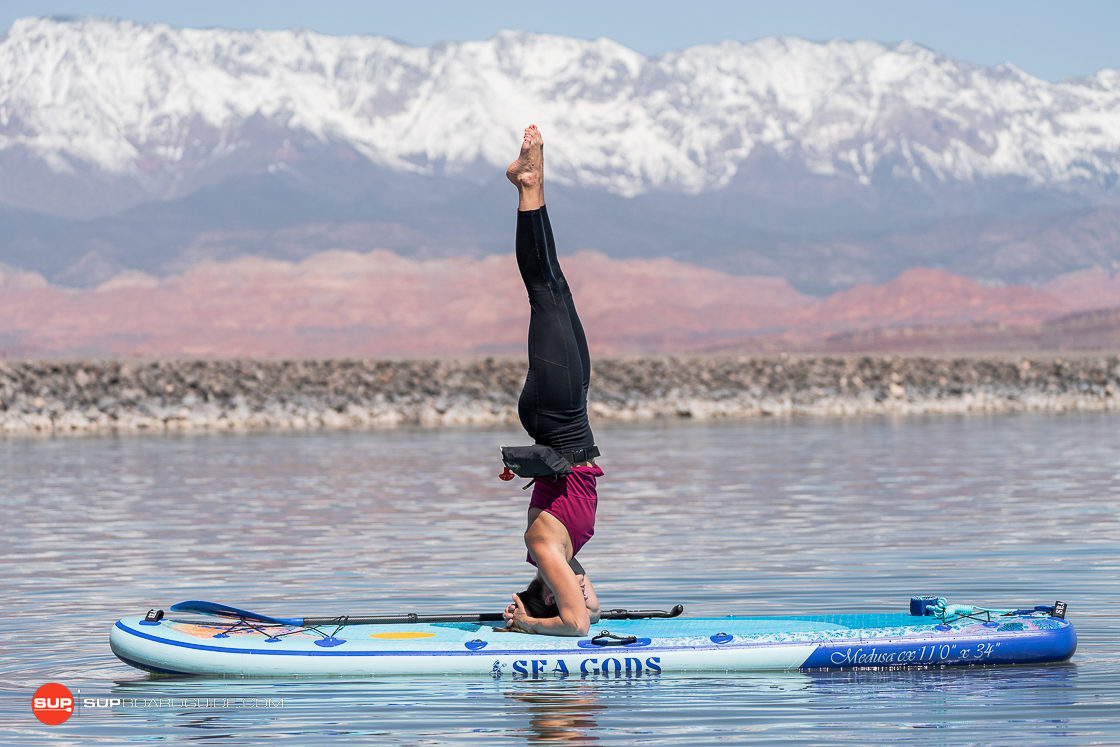
Stand Up Paddleboarding allows us to immerse ourselves in remote, peaceful water environments. If you’re looking to enhance the meditative, full body workout aspect of SUP’ing, SUP Yoga is the way to go.
Admittedly, I am not a yoga pro. Honestly, my best yoga session could probably be called intermediate stretching at best. I grew up doing gymnastics, so that’s where my headstand comes from. But if you ask me to do the standing tree pose, I’ll have to ask you for a hand. With this in mind, you can be assured that if I could get successfully through a flow on each of the boards below, a more advanced yogi will have no problem finding their zen.
Below we’ll rank some our favorite boards for SUP yoga and elaborate on some of the specs, features, and included accessories that made it stand out amongst the multitude of boards we’ve tested out. We’ll also lay out a yoga SUP buyers guide, explain the differences between hard and inflatable yoga SUPs, and provide some tips to make the most out of your board once you get it onto the water. Our goal here at SupBoardGuide is to provide you with all of the technical information and real world experience to help you make the most educated decision when it comes to purchasing a board of your own.
Before we fully get into our list, let’s go over some of the characteristics that we considered to decide which boards make for a great Yoga SUP.
Best Inflatable Yoga SUPs
- Glide Lotus Elite
- NIXY Venice
- Thurso Surf Tranquility
- Retrospec Yogi
- Sea Gods Diatom CX
- iROCKER Cruiser 7.0
- Atoll Enclave
1. Glide Lotus Elite
See Full Review | Check Latest Price
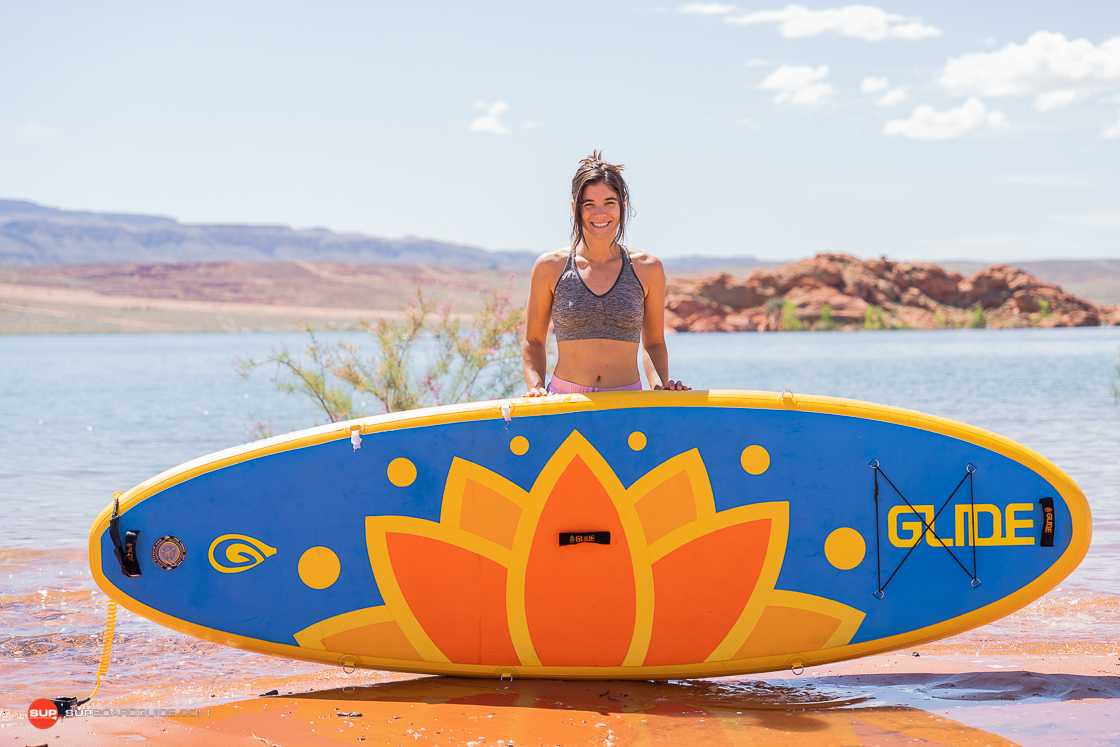
- Tip to tail deck pad so you can maximize the space on the board where you can practice your postures
- Beautiful, bright, and vitalizing graphics that invite you into an energized yet relaxed state of mind
- Extra wide and short (10×35) for exceptional stability
- A middle carrying handle that can uniformly flatten down so you can move through your flow without interruptions but can also easily carry the board
- A 400 lbs maximum weight capacity so you can choose to bring extra cargo or bring along a small child or pet for company
- Minimal bungee cargo space so you don’t have a ton of room to securely attach a large load that this board is able to handle
At 10’ long the Glide Lotus Elite is the shortest Yoga SUP we have tested, but that doesn’t stop it from feeling comfortably stable thanks to its 35” width and excellently rigid construction. The deck pad covers the entire board with a soft, brushed EVA foam that offers plenty of grip. We love that this Yoga-specified SUP encapsulates the relaxing yet energizing vibe that the practice of yoga is meant to provide.
If you look at it with a Yogi’s eye, the minimalistic features on this board fit right into the peaceful vibe that it already has going for it. There truly isn’t much that you have to worry about. On the nose of the board, there is a small but functional bungee cargo area that can fit accessories such as a yoga towel, water, hat, shoes, etc. It also conveniently fits the kayak seat attachment that comes with the board. So if you want, you can kayak to the place you intend to do your yoga, and then remove the seat and put it into the bungee area so you can have a free deck pad. There are also two small velcro loops on the rail of the board meant for holding your paddle – an addition that is very useful to paddle board yoga. In regards to the deck pad itself, we love that Glide decided to make it extend from the very tip of the board to the very tail. So if you dare, you can practice that one-legged tree pose at the very tip of your board and truly test your balance!
One feature that sets this board apart from others on our best Yoga SUP list is the center carrying handle that can completely flatten down. It’s made from material that is flexible enough to flatten out underneath your body instead of annoyingly poking into you. This makes it so you can practice your flow without interruption, but you can also carry the board with ease. It’s a little thing, but it’s like the cherry on top of a great yoga SUP.
2. NIXY Venice
See Full Review | Check Latest Price
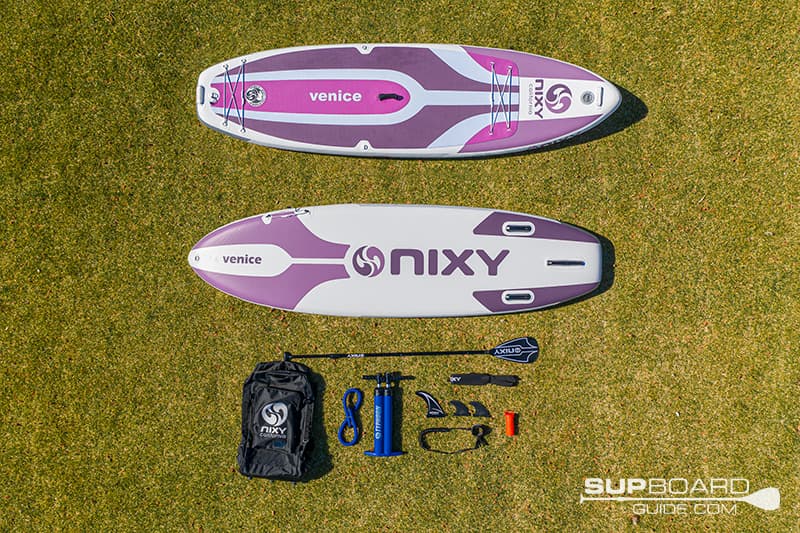
- Quick, maneuverable all-around, but yoga capable board
- Both bungee cargo areas are removable to free up yoga space
- Almost full-length deck pack
- Extra D-rings for kayak seat or gear attachments
- In-built carbon side rails may add stiffness/ performance
- Solo center handle may get in the way during yoga
The Nixy 10’6 Venice is more of a crossover all-around and Yoga SUP, instead of a designated yoga board. This makes it more versatile and a great option for both dedicated SUP Yoga enthusiasts and those just looking for an occasional session. Like most Nixy boards, the Venice is sporty, maneuverable, and easy to paddle in the water but its 34” wide deck gives you plenty of stability to flow through a yoga session. The Venice is lightweight but with a 350 lbs weight capacity, so is more than capable of supporting most adult paddlers and should have no problem bringing along a kid or a pet.
The Nixy Venice has a full-length comfy EVA deck pad (the board pictured is a previous year’s model; the deck pad has since been extended up the nose) that will keep your hands and feet solidly in place as you move through poses. It also has front and rear removable cargo areas, allowing you to bring gear if needed but also free up some deck space to stretch out or practice yoga with a partner. There are 3 handles dispersed at the center, nose, and tail as well as 4 action mounts, and 4 extra D-rings for a kayak seat conversion or other attachments.
Nixy does an awesome job of including high quality accessories to get you started on the water. The Venice comes with a 3-piece carbon fiber hybrid paddle, double chamber hand pump, 10’ coiled leash, a tool-less screw-in fin, repair kit, and a 3-wheel backpack. I personally love the kit-included paddle with every Nixy board, it’s super lightweight and feels effortless to pull through the water. I also really appreciate tool-less screw-in fin, as I think they’re more secure than a snap-lock system and hold up better over time than the slide-lock fin box. The nixy backpack is also one of our favorites for its roominess and large front zipper compartment to store your smaller accessories outside of the main pocket, but we question if the third wheel is truly necessary.
3. Thurso Surf Tranquility
Read Full Review | Check Latest Price

- Parallel shape adds stability
- Updated construction is lightweight and rigid
- 12 D-rings add versatility for gear attachments
- Included carbon paddle
- No center handle
- Paddle holder to store your paddle during your practice
- We would have liked to see a full length deck pad for this yoga SUP
Thurso Surf’s Tranquility is super stable at 10’8 long and 34” with a wide, parallel shape – ideal for those who want to practice Yoga on the water.
The built in features on the Tranquility give it a bit of customization ability without taking away from its true purpose as a Yoga SUP. We love the addition of the action mount on the nose to document your paddling adventures with a camera, attach a cup holder, speaker, or anything else you could think to set up. This board also has a front a rear cargo area as well as D-rings for a kayak conversion kit. The velcro paddle holder on the side lets you stow your paddle out of the way while you practice yoga, and the lack of center handle allows you to fully utilize your deck space. One thing I would suggest to Thurso Surf is to fully cover the board with the deck pad all the way to the nose. While this area isn’t often used, it’s nice to not have to worry about running out of deck space as you move through your Asanas.
We’re always happy with Thurso’s list of included accessories, and the Tranquility is no different. With the purchase of this yoga SUP you’ll receive a 3-piece carbon hybrid paddle, rechargeable electric pump, fins, 10’ coiled leash, and a wheeled backpack. Each piece in this kit is of great quality, especially given the affordable overall price. I personally love Thurso’s carbon hybrid paddle. It just feels super rigid in the water and makes your ride feel smoother and more effortless.
4. Retrospec Yogi
See Full Review | Check Latest Price
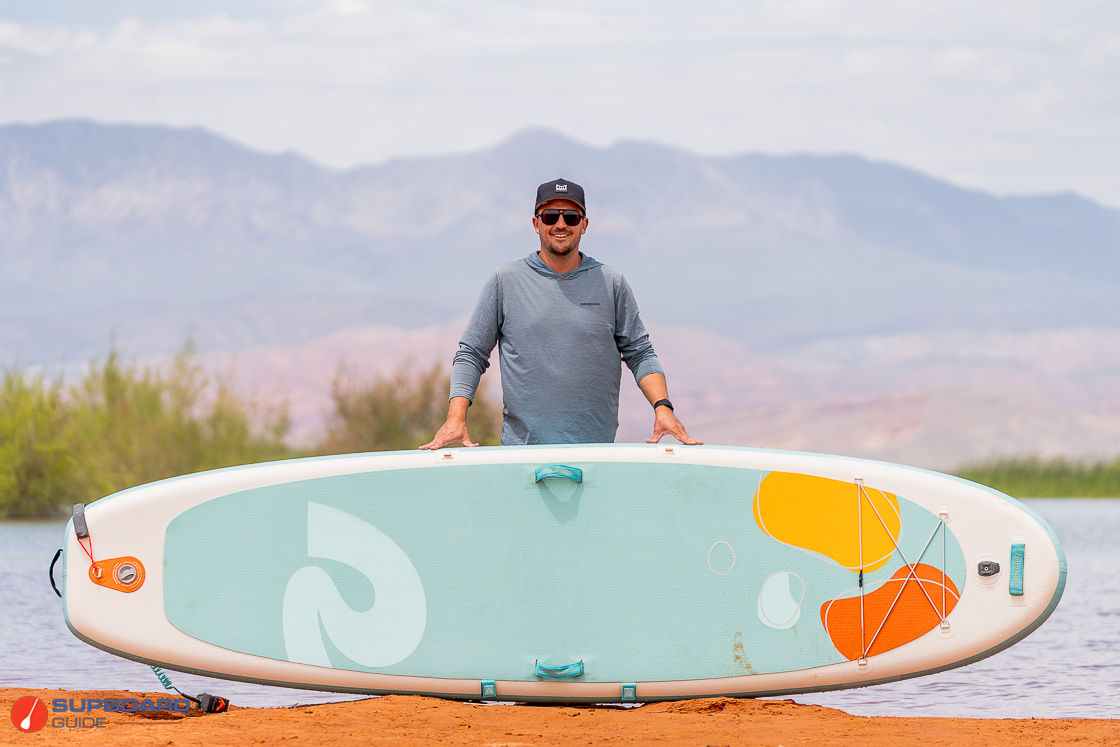
- Stacks of stability
- Good all round performance
- Loads of deck space to roam around on!
- Good accessory fittings
- Nice bright friendly design
- Very well priced at under $400 for the package
- While very lightweight, the Yogi does not have as much rigidity as many others on this list, making this a better choice for lighter paddlers
The Retrospec Yogi is the perfect choice for getting into SUP Yoga on a budget. This stable iSUP features a full-length deck pad with plenty of clear space for stretching out. The small cargo area on the front has enough room for water, a small dry bag, and other accessories.
Rather than a center carrying handle, Retrospec has two side handles and is compatible with a shoulder strap for easier carrying and kayak seats for seated paddling. The slide-in fin box is tool-less and easy to use, and Retrospec also includes a waterproof phone bag so you can easily access calming music or follow along with a Yoga video without worrying about your phone getting wet.
5. Sea Gods Diatom CX
See Full Review | Check Latest Price

- Super stable at 34” wide, making it a great beginner board and Yoga
- Lightweight, high quality construction makes getting up to cruising speed easy
- Very maneuverable, despite being a larger board
- Versatile iSUP, lots of features without crowding your deck space
- Ships in minimalistic, compostable packaging
- SeaGods Lifetime Warranty
- Bright, beaming, and beautiful design
- Standard length deckpad may be limiting for Yoga
- You will be forced to talk to strangers asking you about your board because it’s so unique
The Sea Gods Diatom CX isn’t technically a Yoga SUP, but it certainly works well for it! The Diatom is an extra stable, and extra high quality cruiser paddleboard that makes a great choice for beginners and intermediate paddlers who aren’t looking for a dedicated Yoga board.
The Diatom is a fun and agile board on the water, but when you set the paddle down, it has plenty of capacity, rigidity, and stability for moving through sun salutations and other practices. It would be nice if the deck pad extended a bit further up the nose, but there is plenty of clear space for you to lay out as it is. Meanwhile, there is ample cargo room and multiple accessory mounting points to hold everything secure.
Last, but not least, the Diatom CX – like all of Sea Gods’ boards – features some incredible artwork commissioned from real artists. It’s hard to believe, but this board looks even better in person, so don’t be surprised when you start making new friends when they ask where you got it!
6. iRocker Cruiser
See Full Review | Check Latest Price
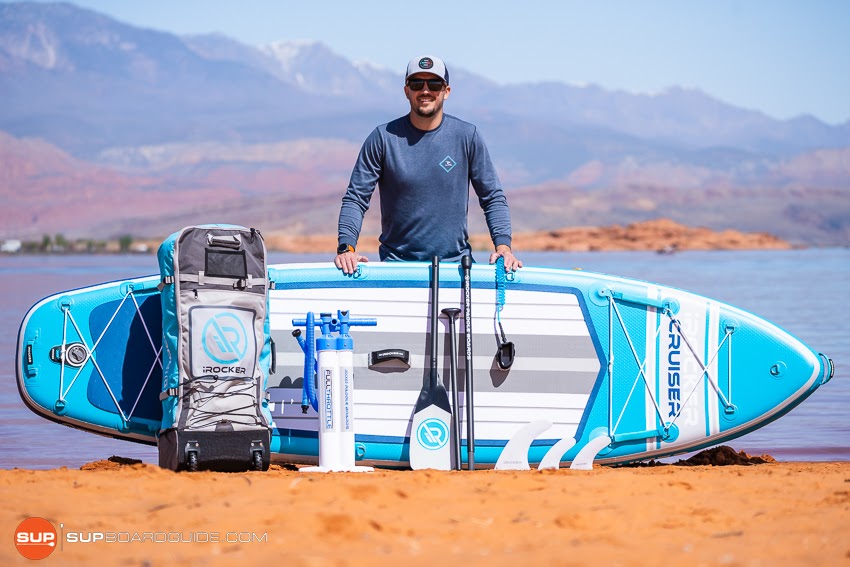
- Stable enough for yoga but sporty enough for all-around use
- Faster and more maneuverable than other listed boards
- Durable construction for an affordable price
- Front and rear cargo areas and extra D-rings so you can bring plenty of gear
- Stamped deck pad is a comfy, grip focused, stylistic touch
- Good quality included accessories
- Deck space is limited for yoga due to its features/accessory compatibility
- Not a true dedicated yoga SUP, but an all around SUP that you could do yoga on
- Would like to see rear action mounts shifted back or incorporated into rear d-rings
If you are looking for a board that you can use for both yoga and all-around paddling as well, the iROCKER 10’6 Cruiser will be a great choice. At 34” wide and 10’6 long, it’s a great balance between stability and sportiness. You’ll be able to practice SUP yoga without making sacrifices when it comes to speed and maneuverability, and you’ll have no problem loading on gear, kids or pets with the Cruiser’s 400 lbs weight capacity.
Like most iROCKER boards, the Cruiser is decked out in features to maximize compatibility and versatility. There are front and rear cargo areas, each possessing a safety strap for passengers to hold onto, as well as 3 carry handles on the nose, tail, and center of the board. The Cruiser is kayak seat compatible, with its 4 extra D-rings , and has 4 action mounts to set up a camera, phone, speaker, cup-holder or fishing rod holders. We’re also big fans of iROCKER’s deeply grooved deck-pad that transitions into a high traction diamond pattern on the tail to help with step-back turns. While not as much as a specialized SUPs as the other boards on this list, the Cruiser will enable you to do any SUP activity, yoga included.
As always, iROCKER sets you up with a list of great accessories right out of the box. Along with the 10’6 Cruiser, you’ll receive a 3-piece carbon hybrid paddle, 3 snap-lock fins, double chamber/triple action pump, 10’ coiled leash with key pocket, repair kit, and a carrying strap. Each of these accessories is high quality and built to last over tons of use.
7. Atoll Enclave
See Full Review | Check Latest Price

- One of the only compact iSUPs with a full-length deck pad
- Excellent construction with fusion PVC, welded rails, and PVC stringers
- High stability with 34” of width and a wide tail
- Tracks well thanks to twin 8” fins
- Maneuvers easily
- Great 5-piece carbon fiber paddle feels great
- Travel-friendly without sacrificing performance
- The offset center handle may get a little more in the way during Yoga compared to a fully centered handle or side handles
The new Atoll Enclave may seem a little out of left field for a list of Best Yoga SUPs since it’s a compact board, but with a full-size cruiser shape with a wide tail and a full-length deck pad, it actually makes perfect sense as a Yoga SUPs for paddlers who travel frequently or are short on storage space.
Like several other boards on this list, the Enclave is 10’6 x 34” x 6”, and it has a comfortably wide square tail shape that gives it excellent stability. Unlike most compact iSUPs, the Enclave has a deck pad that spans all the way from nose to tail. There is still a small gap in the middle that allows the board to fold in half for compact storage, but the gap is narrower than my foot, and I don’t find it to negatively impact my ability to move around on the board.
Lastly, the Enclave is extremely versatile. Besides its compact packing size, the Enclave has a completely customizable cargo management system that lets you quickly and easily rig it for any activity – including removing the bungee cord for more unencumbered room on the deck.
What Makes a Great Yoga Stand Up Paddle Board (SUP)?
As with any SUP, a great yoga SUP is one that best fulfills your needs as both a paddler and a yogi, which of course will vary among individuals. Generally speaking, a great yoga board is one that is stable enough to move through your poses and around the board, not massively difficult to carry or paddle, and loaded with the right features and versatility to fully enjoy in any aspect of the sport.
When it comes to SUP yoga, stability is your board’s most important attribute. Stability on any SUP primarily comes from the width of the deck, so you’ll notice on this list most of the boards are between 33” and 36” wide. However, the shape of the board also plays into this, as a less tapered 33” wide board will have more stability than a tapered board with the same width. This is because tapering a board decreases the surface area that is in contact with the water, thereby decreasing stability.
Now when it comes to paddling the board for longer distances, most will find that the tapered 33” wide board (this specific width is just for example purposes) is faster and easier to pull through the water than a non tapered board of the same width. This goes back to our note about surface area, as the tapered board has less surface area in contact with the water, thus reducing friction, and allowing the board to move over the water more easily. This is one of the trade-offs that you’d have to consider when picking out your own board. If you know you’ll have to paddle a considerable distance to get to your yoga spot, it may be worth it to you to opt for a tapered option even if you lose a small amount of stability.
As a small note, you can play around with different width and tapered/less tapered combinations to find your best match, but keep in mind that as you increase your width, it can be harder to keep proper paddling form, especially if you’re a smaller person with less reach. Though we’ve found that this can be mitigated by stepping your foot opposite to your paddling side closer to the midpoint of your board and moving your paddling foot closer to the rail.
When it comes to considering features, this always comes down to personal preference. For most yoga specific boards, you’ll want to keep an eye out for a full length deck pad that gives you plenty of space to stretch out and move around the board as you transition between poses. You’ll also want to consider finding the right balance between traction and comfort, as you’ll want to be able to comfortably lay out on your deck, but will need the grip to keep your hands and feet stable with each position.
Another thing to consider is your board’s versatility and compatibility. Some specialized yoga SUPs opt not to incorporate multiple cargo areas to free up space on the deck, while others choose to only incorporate one, or opt for removable bungee cargo areas to give you some versatility. Also pay attention to the amount of D-rings or action mounts you’d like on your board that would give you the ability to attach kayak seats, more cargo areas, or set up a camera, cup holder, speaker etc. This really just comes down to your own needs regarding additional bells and whistles.
Lastly, we like to evaluate the overall value of the kit. We appreciate companies that include quality accessories such as carbon paddles, double action pumps, and high quality roller bags for a reasonable overall price.
With that in mind, we have an array of boards on our list that could fit any paddlers needs and preferences when it comes to the above characteristics. We hope you’ll find the right math on our list of Best Yoga SUPs of 2025.
Yoga SUP Buying Guide
While we are confident that any board on this list would satisfy any paddlers needs, we want to feel confident to shop around even if that does take you outside of your recommendations. Below, we’ll go through a yoga SUP buying guide to help you know what to consider before making a board purchase.
- Stability
Stability is always the most important factor when shopping for any SUP, but deserves even more emphasis when it comes to yoga SUPs. There’s no worse way to kill your vibe and break you out of a meditative state than an unintentional dip in the water. A yoga SUP needs to be stable enough to allow you to comfortably flow through different poses and different hand or foot placements without posing a significant challenge to your balance. Yoga SUPs will typically be wider and less tapered to improve overall stability. - Paddling Ease/Performance
Because yoga SUPs tend to be wider or less tapered, they are bound to be a bit slower when compared to a smaller all-around or a more touring oriented board. However, if you know you’re going to have to paddle moderate to long distances before settling into your yoga spot or if you’re planning to utilize your board for more casual paddling as well, you’ll want to find a good balance between stability and performance. Eah board on this list is stable enough to get through a yoga session, but not so wide or heavy as to make it a chore to actually paddle.As a side note, yoga SUPs also come with some maneuverability challenges due to their size and width. If maneuverability is really important to you, keep an eye out for boards with a raised kick pad as we mentioned on this list.
- Durability/ Construction weight
Because specialized yoga SUPs can be a considerable investment, it’s always nice to have peace of mind that it’s constructed to last through multiple seasons and uses. The inflatable boards on this list utilize durable dual or triple layer PVC construction, while the hard SUPs are sturdy fiberglass/resin sealed foam core. We’re confident that all of these boards will hold up to heavy use or minor dings and drops, but keep in mind that construction plays a huge role in board weight. Triple layer inflatable boards will generally be heavier than those with dual PVC layers, while hard SUPs that incorporate wood sandwiching will also be heavier than other hard board options.When considering your board weight versus its construction, think about the distance that you’d normally be carrying it, and if you’ll typically be transporting it alone. As a smaller solo paddler that’s of about average strength (5’2 and 140lbs), I like my boards to be in the 21-25lb range.
- Features
What I mean by ‘features’ includes things like your deck pad, d-rings, action mounts, cargo areas, paddle holders, handle placement, and fin set-up and box. Again, this a personal preference thing, but think about what type of balance you like between grip and comfort on your deck pad, as well as how often you’ll want to bring along gear. Also consider how versatile you’d like your board to be when it comes to attachments and accessories. Lastly, note what type of fin-set up would be best for your paddling style or stability needs. Single fin set-ups will contribute to added speed, while 2+1 set-ups slightly improve stability. - Accessories
When it comes to accessories, think about what you’ll need to be included in your paddling kit. If you need all of the accessories to get started, look for an all inclusive kit that provides a paddle, leash, pump, and bag with your board. If you already have a paddle of choice or an electric pump, then you can search for a board that does not include a paddle and won’t need to pay too much attention to the quality of an included hand pump.
At this point, you’ve probably noticed that each board characteristic in our buying guide relies majorly on your personal preferences and requires you to consider some trade-offs. Unfortunately, there’s no ‘one size fits all’ when it comes to the perfect yoga SUP. However, with this buyers guide in mind, you’ll be able to feel confident narrowing down your board search to best match your needs.
Inflatable Yoga Board or Hard Yoga Board
I want to preface this section by saying that when it comes to comparing hard SUPs to inflatable SUPs, it’s not so much that one is ‘better’ than the other. Rather, each option has their own benefits that can better fit an individual’s environment, lifestyle, storage capabilities, etc. Below, we’ll list some of our favorite attributes of both inflatable and hard SUPs.
Benefits of Using and Inflatable Yoga Board:
- Stability/weight support
Inflatable SUPs generally have higher weight capacities than hard boards of a similar shape and size. This give you the option to bring along more gear or an extra paddler without always needing a larger board. - Damage resistant
Because of their construction, hard boards are easier to scrape, chip, or crack, whereas the PVC layers on iSUPs are extremely resistant to damage. An iSUP can hold up against most drops and collisions without even leaving a noticeable mark on the board. This does come with the caveat that if an iSUP does get damaged, it usually needs to be sent out to the company for repair, instead of being done yourself or at a local shop. - Weight
iSUPs are typically lighter than similarly sized hard boards. This makes it easier to carry them over long distances, but also allows them to be more easily pushed around by tide, wind, or choppier waters. - Storage and transport convenience
A common appeal of iSUPs is that they are able to be deflated and rolled up into a bag that can easily be stored in a trunk or a closet. It makes owning a paddleboard more feasible for those living in more confined spaces such as apartments or dorm-rooms. - Cost
Inflatable SUPs are generally more affordable than similarly sized hard SUPs. They also typically come with an included paddle, leash, and fins whereas most hard SUPs do not.
Benefits of Using a Hard Yoga Board:
- Performance in non-ideal conditions
Because hard SUPs are typically heavier than iSUPs of a similar size, they are less prone to being pushed around by wind, tide, or bumpy water. - Speed
Hard SUPs usually have better tracking than inflatables and are designed to cut more through the water instead of gliding over top, making them a faster performing board. - No need for extra accessories
Hard SUPs don’t require a lot of additional accessories such as hand pumps and roller backpacks. You’ll be ready to paddle with just your SUP, paddle, leash and life jacket. - Ease of repair
Although hard SUPs are easier to damage, they’re also easier to repair. Most dents, scrapes, or cracks can be fixed at home with a fiberglass and epoxy patch. Even if it is outside of your comfort zone, most local board shops will be capable of board repair without you having to ship it out. - Rigidity
Hard SUPs are more rigid than iSUPs, which can be more comfortable when it comes to a relaxing yoga session.
Tips for Making the Most of Your Yoga Board
Once you’ve unpacked and readied your board, it’s time to take it out on the water and put it to the test. If you’re a beginner paddler or new to the SUP yoga scene, this can be slightly overwhelming. Our best advice is to just paddle around and have fun. Jump up and down, try to walk from nose to tail, push your own and your new board’s limits to see what you and it can handle before falling in. Besides that, we’ve compiled a list of things we’ve learned along the way that will hopefully be helpful tips to help you make the most of your board.
- Get comfortable falling in
Whether you’re new to yoga or have been practicing on land for years, falling in during a SUP flow is nearly inevitable, especially if it’s your first time. The bottom line is that there’s more factors at play than just moving between poses. The wind, tide, or any wake in the water can challenge your balance at any point, in any position. It’s important to remember that falling in is no big deal as long as you wear your leash and know how to get back on your board (the easiest way is to place your hand by the handle and push yourself out as if you were getting out of a pool). It’s also fun to incorporate the water into your routine after a series of high intensity movements. - Practice paddling form
Yoga SUPs are typically wide, and while this does help with stability, it can often challenge your paddling form. With a wider yoga board, you’ll want to focus on stacking your shoulders to keep your paddle vertical as it enters the water and as you pull through your stroke. If you have a smaller reach like I do, you can try shifting your feet towards whichever side you’re paddling on. - Take it slow
Yoga on a paddle board is much different than yoga on land. Take it slow as you start your SUP yogas sessions and build up to more challenging flows and movements. Also remember not to take it too seriously, the challenge is part of the fun. - Use the entire deckpad
Yoga SUPs generally have a lot of space on the deck to allow you to spread out and really get into your routine. As you’re starting out, you’ll want to spread yourself out on as much of the deck space as possible to help with stability. Beginners will typically be most comfortable keeping at least 2 points of contact with their board, but as you progress you can challenge yourself with one point of contact movements (just remember it’s okay to fall in). - Find a secluded spot
Another way to help with stability when you’re just starting out is to find a secluded, sheltered spot. Usually I’ll look for a cove that is blocked from the wind and boat wake to ensure that choppy water won’t interfere with my flow. This also helps with your focus and meditation, as these spots tend to be quieter and harder to reach.As a side note: always check that the water is deep enough so that you won’t get hurt on the bottom if you fall in.
- Bring a lifejacket
As we’ve said several times, falling in is super common when it comes to SUP yoga. Of course, this is part of the fun, but always be sure to bring or wear a lifejacket or PFD (personal flotation device). Accidents happen, and it’s much better to be prepared from the start than to wish you had been in case of an emergency.
Conclusion
Hardboard or inflatable, new or experienced, our number one recommendation for all paddleboarders is to just remember to have fun! Yoga boards are great for trying a new water sport away from the noise and bustle of the city, and will provide a new challenge to your meditative sessions. Whether you’re going out to work out your muscles or to find a nice and quiet place to think while you stretch, yoga boards are built for all sorts of paddlers and activities. So make sure to experiment, try new things, and enjoy the wonders of nature and the water the next time you go out on your yoga paddleboard!
Thank you so much for reading, and we hope that this article has been helpful to you in learning about yoga paddleboards. If you have any questions, or want our feedback on a particular yoga board you found, send us an email or leave a comment below! We also update our articles based upon the comments we receive, so if you feel like there is something we missed that other yoga SUPers should know about, be sure to let us know! Be sure to check us out again in the future as well, as we update our lists based upon our reviews of the latest and greatest yoga boards.
And remember to have fun paddleboarding!
SupBoardGuide
Latest posts by SupBoardGuide (see all)
- Best Kids Paddle Boards (SUPs) – 2025 - November 11, 2025
- Best Stand Up Paddle Board for Fishing – 2025 - November 11, 2025
- Best Yoga SUPs of 2025 - November 11, 2025




Great overview of the top yoga SUP boards for 2025! I love how you highlighted the stability and features that are essential for a good yoga experience on the water. Can’t wait to try some of these out this summer!